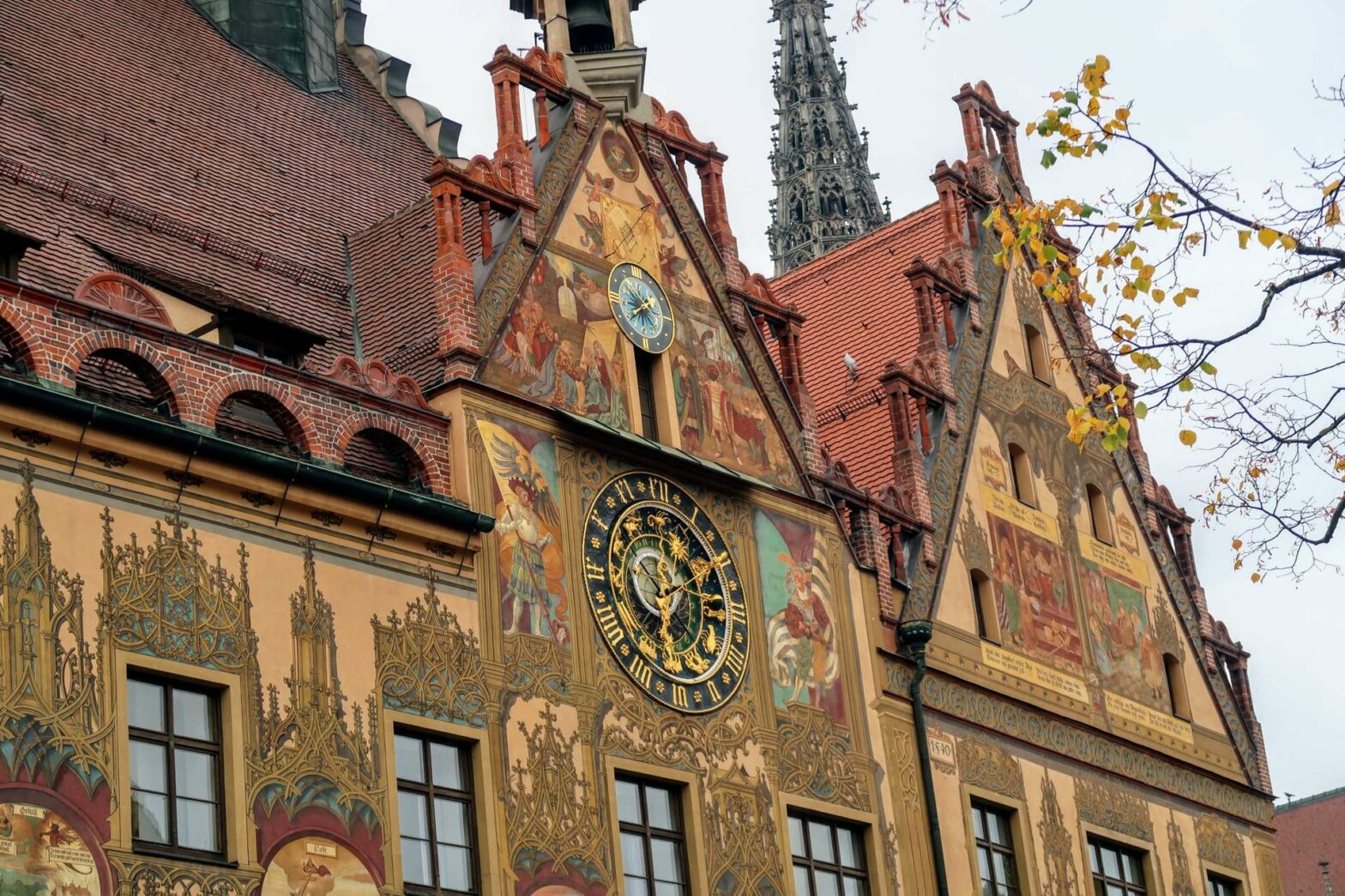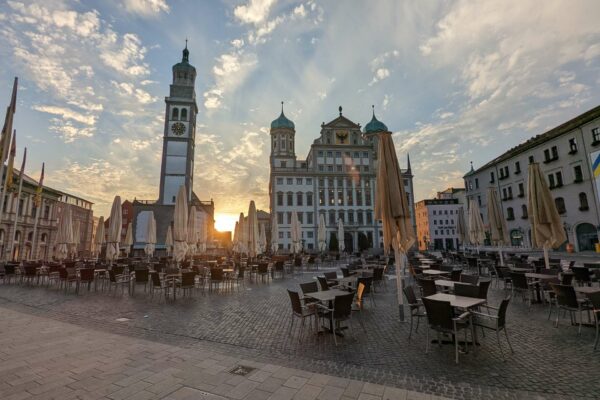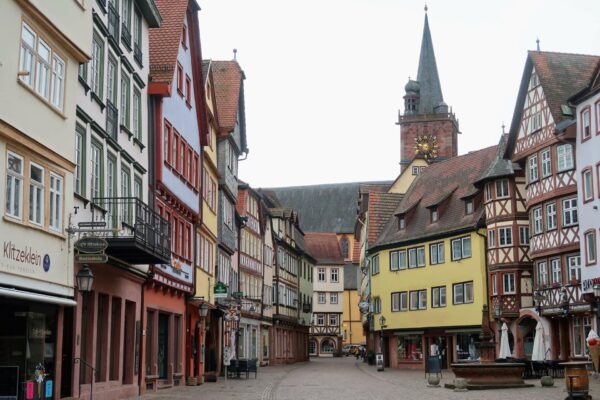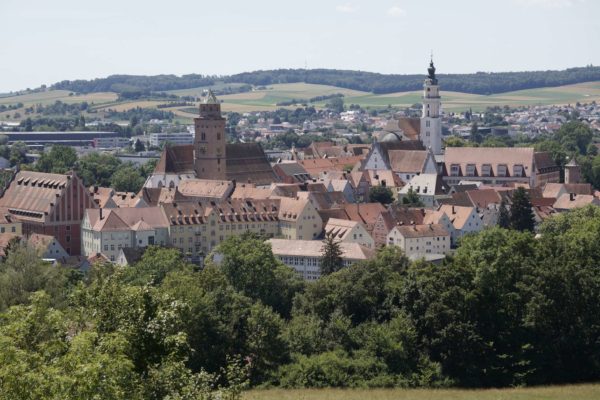By Vicky · Published Oct. 24th, 2022 · Updated Mar. 23rd, 2023
When you buy through links highlighted with an asterisk (*) on this site, we may earn a small affiliate commission at no cost to you.
This walking tour around Ulm visits the main sights, including the cathedral, fisherman’s quarter and more.
Page Contents:
Location
This walk starts from Ulm Train Station, on the western edge of the city centre. Ulm is 1hr20 from Munich on the fast trains and 1hr10 from Stuttgart.
Ulm Walking Tour Map
Get the route by downloading the .gpx or .kml file below. For navigation with Maps.me on your mobile phone, simply download the .kml file and open to add it to the Maps.me bookmarks.
Tips for Ulm Walking Tour
- Don’t walk up the cathedral tower if you are afraid of heights!
- There are a couple of worthwhile museums in Ulm, the Bread and Art Museum being the most unconventional and perhaps the best.
- Check out other walks on our Germany Hiking Page.
Top Sights in Ulm
On this self-guided walking tour you’ll see the main sights and attractions of Ulm. One day is the perfect amount of time to spend in Ulm.
- Stadthaus
- Ulm Minster
- Fischersviertel (Fisherman’s Quarter)
- City Walls
- Marktplatz, Rathaus & Museums
- Museum der Brot & Kultur
This is a self-guided walking tour, but there is a great guided walking tour of Ulm* you can do. The guided tour visits most of the sites on this tour, including Ulm Munster, the Fisherman’s Quarter and the splendid Rathaus. It starts from the Stadthaus, our stop Number 1.
Ulm Walking Tour Route
This walking tour starts from Ulm Train Station.
Directions: From the train station, follow the signs for Ulm Innenstadt/City Centre. This will lead you underground, then back up again in a little shopping square. Head slightly right along the pedestrian street and soon you’ll arrive at the Munsterplatz, the main city square.
1. Stadthaus
Key Information: Tourist information open Mon-Sat 9am-6pm, Sun 11am-6pm. The exhibitions open from 10am (11am Sundays) and are free to get in.
The Stadthaus (Website, Tripadvisor Reviews*) is a modern white building on the right-hand side of the square. An architect from New York designed it and its construction in the early 1990s was fairly controversial. The town residents were divided on whether it added to or detracted from the ambience of the Munsterplatz.
The tourist information is at the base of one section, and there are several free exhibitions inside. The top floors contain rotating exhibits of variable interest, but check out the terrace from which there are good views of the cathedral opposite. The best little exhibition is in the basement and displays artefacts found during excavations to build the Stadthaus.
On the ground floor of the other building is a nice cafe offering homemade cakes. On the Munsterplatz itself there’s a market on Wednesdays and Saturdays selling fruits and vegetables, meat, flowers, bread and more.
2. Ulm Minster
Key Information: The cathedral is open Apr-Sep 9am-6pm and Oct-Mar 10am-5pm daily, the tower closes 1 hour earlier. The cathedral is free to enter, while tickets to the tower cost €5/3.50.
The Gothic Ulm Minster (Website, Tripadvisor Reviews*) is a must see and highlight of this walking tour. In the gift shop, you can pick up a guide to the cathedral – an in-depth booklet for €3, or a shorter leaflet for €1 that takes you to the top 10 sights of the cathedral. It’s a good idea to pick up one of these leaflets, with the cheaper one recommended unless you have a really strong interest in the building and its history.
Slightly surprisingly, the Ulm Minster has the world’s tallest church tower, at 161.53 meters high. When it was first envisioned in the Middle Ages, the town citizens had grand ideas of a huge church. Their big ideas came to a halt in 1543 with a decline in trade through Ulm resulting in a lack of money. Three hundred years later, in 1844, construction started again in earnest and the builders completed the tall tower in 1890.
Walking up the tall tower is slightly scary since the spiral staircase is quite tight and you can see all the way down to the square below on every rotation. However, the view from the top is worth it.
Inside the Cathedral
Down in the church, don’t miss the choir stalls, made of oak carved in 1469-1474. The 99 wooden figures are either from the bible or famous people from antiquity such as the philosopher Cicero. At the back of the church, you can see the famous Ulm Sparrow, today a symbol of a city. Legend goes that the (slightly stupid) townspeople couldn’t fit a cartload of long wooden planks through the city gates. They didn’t think of turning them lengthways until they saw a sparrow carrying a twig turn its head to get through a narrow gap. After this, the townspeople rejoiced as they could just turn the planks around rather than knock down the city gate.
Directions: Leave the Munsterplatz behind the Stadthaus and down a pedestrianised street with the Neuer Bau (a warehouse from the 16th century) on your left. At the park turn left, then right over the two bridges into the Fischersviertel.
3. Fischersviertel (Fisherman’s Quarter)
The Fischersviertel* is a historic district of Ulm that’s great to walk through. It’s a picturesque area with many old half-timbered houses from the 15th-17th centuries and two channels of the River Blau. A lot of the old houses have their foundations partly in water and the soft ground has shifted, leading to buildings subsiding and tilting quite precariously. Fishermen lived here in the Middle Ages and fished on the Danube in little boats. Shipbuilding later became more important, constructing shallow-bottomed tub-like boats to transport people and goods along the Danube.
As you walk down the main street you will see many cute old houses. Towards the end of the street, turn left to walk across the Häuslesbrücke. This bridge was built in 1316 and is the oldest bridge in Ulm, and crosses the two branches of the Blau River. Look back from the bridge and you’ll see the historic Schmales Haus (narrow house), now a hotel*.
The Schwörhaus and more
On the other side of the river, pop up the steps on the other side of the road and round the corner into the square. To your left you’ll see the Schwörhaus, or oath house. It’s a lovely building where the city mayor swears an oath every year ‘to serve rich and poor alike’, a tradition started in 1345. There’s a free exhibit about the city’s history inside (the Haus der Stadtgeschichte), but the captions are all in German.
Leave the square and head back to the Fischersviertel. You’ll soon see the Schiefes Haus, or Leaning House (today a lovely hotel*). Look at its front, then head around the back. It’s very cute and precarious-looking, hanging over a little canal. It was built in 1406 and today tilts around 10 degrees, but it’s good to know that the building has been renovated such that it’s stable even in its leaning position. It used to be in the Guinness Book of World Records as the ‘most leaning hotel in the world’, until recently overtaken by a hotel in Abu Dhabi.
Cross the next bridge and you’ll reach Fischerplätzle, a little square that used to be a small harbour on the Danube. The Schönes Haus (beautiful house) is on this square, another nice old house and the centre of the mariners guild.
Directions: Walk up the steps to the city walls and turn left.
Discover Walking Tours of other Bavarian Cities
4. City Walls
From the City Walls* you can see the River Danube on one side and historic townhouses on the other. This wall was built at the end of the 15th century. Older walls, from the 13th century, have mainly since been destroyed though you might spot a few remnants around the city. Walk along the wall until the Metzgerturm, a stone tower that like other buildings is also leaning quite considerably.
Directions: Head down and through the Metzgerturm up to Ulm Marktplatz.
5. Marktplatz, Rathaus & Museums
The most prominent building on the Marktplatz is the splendid town hall, or Rathaus*. The Rathaus is fully covered in paintings. There’s a depiction of a merchant tub sailing on the River Danube, as well as virtues and vices such as hope. The oldest part of the building dates from 1370 though it became a town hall only a few decades later. Don’t miss the astronomical clock from 1520, showing the signs of the zodiac.
Inside (the entrance doors are not signed, but are open), you can see a full-size replica of the world’s earliest hang glider. This was designed by Albrecht Berblinger in 1811, a tailor who observed owls to try and replicate their flight. Unfortunately, the weather was bad on the day Albrecht tested his machine and instead of soaring through the air it was a big flop and he fell into social ruin. However, today it’s thought his original hang glider was a good design and would have worked if the weather had complied.
Museums on Ulm Markt
Key Information: Both the Museum Ulm and the Kunsthalle Weishaupt are open Tue-Sun, 11am-5pm. Tickets are €8/6 to Museum Ulm, €6/4 to Kunsthalle Weishaupt, or €12/10 for both.
At the east end of the Marktplatz is the Museum Ulm (Website, Tripadvisor Reviews*). It’s located in a rather nice house with lovely ceilings and period furniture and contains a mix of modern art and archaeological finds, the most famous of which is the Lion Man. This is a Stone Age sculpture from over 30,000 years ago, carved in ivory from a mammoth tusk and one of the oldest sculptures in the world.
The layout of the museum is slightly complicated and most exhibits don’t have English captions, though most items are self-explanatory. Don’t miss the rooftop garden, from which you have a great view of the cathedral.
Across the road from the Rathaus is the Kunsthalle Weishaupt (Website, Tripadvisor Reviews*). It’s a much smaller museum than the Museum Ulm and displays modern art along with old artworks. There are some famous pieces, for example by Rothko and Andy Warhol and the museum is nicely laid out. It’s another building with interesting architecture, and again you have nice views of the cathedral from the balcony near the top.
Directions: Walk left from the Kunsthalle and to the backside of Ulm Cathedral. Continue out the other side of the square along a cute pedestrian street. At the T-junction turn left then right again, and through the small square to the big white building and museum.
6. Museum der Brot und Kunst
Key Information: Opens at 10am every day, closes at 3pm on Mondays, 7pm on Wednesdays and 5pm the rest of the time. Tickets are €6 and include an audio guide (available in several languages).
The Museum der Brot und Kunst, or Museum of Bread and Art (Website, Tripadvisor Reviews*) is a surprisingly good museum. The building itself is lovely, with huge exposed wooden beams. The museum is a mix of artworks that feature bread or grains such as wheat, along with everyday objects associated with bread. There’s also a history of breadmaking, the discovery of yeast, the impacts of famines and more. It’s also about how bread can be evocative and how certain types of bread are associated with certain types of lifestyles.
The written descriptions are in both German and English, and there’s an audioguide in English (which is interesting but rather long and could take hours and hours if you listen to all the entries).
Directions: This is the last stop on the Ulm Walking Tour. Head around the back of the museum and left back towards the cathedral square. Then turn right along the broad pedestrian shopping street to reach the train station. Alternatively, take the bus to Wiblingen Abbey (see below) to wonder at the amazing library.
Best Places to stay in Ulm
Budget: Ibis Budget Ulm City* – a solid choice not far from the centre of town with small and basic but clean rooms. There’s not much atmosphere, but it’s a great price for its location.
Comfort: Hotel Schiefes Haus* – stay in one of the top sights in Ulm, the leaning house, almost toppling into one of the pretty river channels. It’s got a great location near the centre of town.
Comfort: Hotel Schmales Haus* – similar to the Hotel Schiefes Haus and in another historic building, this hotel also has a great location and lots of character.
Wiblingen Abbey
Key Information: The basilica is open every day 9-6pm in summer and 9-5pm in winter, and entrance is free. The library and museum are open March to October, Tue-Sun, 10am-5pm. In winter they’re open only on weekends and holidays 1-5pm. Tickets are €5.50/2.80 for adults/reductions. Take bus Number 4 from Ulm town centre to Pranger a bus stop right at the front of the Abbey (journey takes 11 minutes, leaves every 10 minutes).
Wiblingen Abbey (TripAdvisor Reviews*) is a huge monastic complex and former Benedictine monastery. You can enter the large, Baroque basilica in the centre for free, and admire its high ceilings and architecture. Wiblingen Abbey library is particularly renowned as one of the most beautiful (over-the-top) rococo rooms.
To enter the library you have to get a ticket for the library and museum. Unfortunately, the museum is all in German, but you can get an English audioguide for the library. You can also wander around the monastery grounds to admire the outside of the buildings, some of which are falling into slight disrepair.
For more walking tours and hikes in Germany, see our Germany hiking page.








